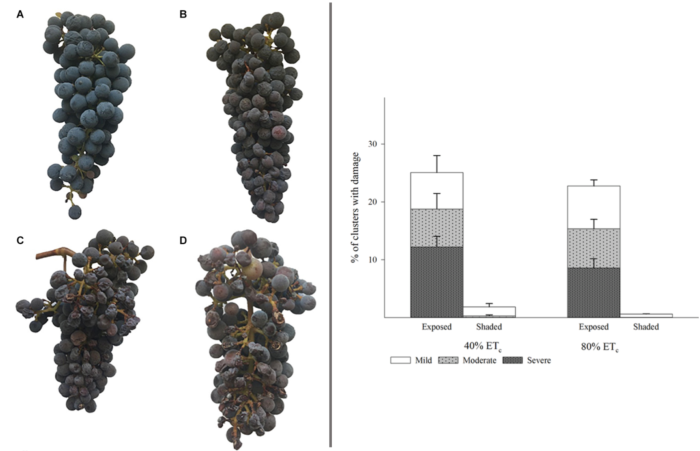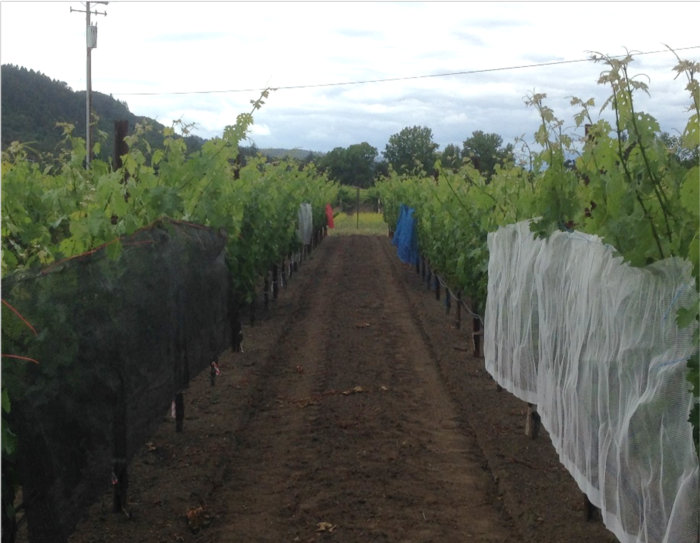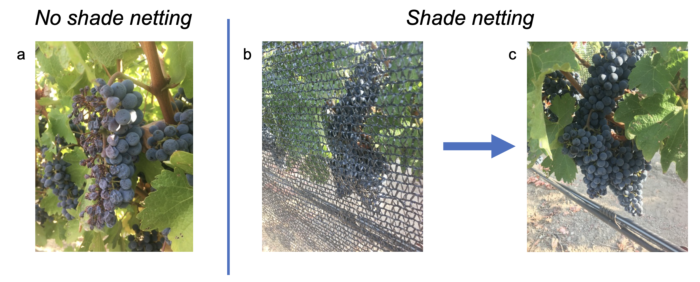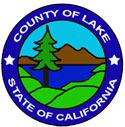Current Newsletter
Supplementary - Questions with the Expert
We asked an author cited in this article important questions provided by readers. Check out our short interview with Ph.D. Candidate, Lauren Marigliano here:
September 2022: It's cooler in the shade - the what, when, why, and how to use vineyard shade netting
Christopher Chen, Ph.D.; Integrated Vineyard Systems Advisor
UC ANR - Sonoma, Lake, and Mendocino Counties
Extreme heat and solar radiation are becoming more prevalent concerns for wine grape production as average global temperatures rise. Sudden heat wave events and prolonged heat spells can raise cluster temperatures up to 113 ºF in appelations previously considered ‘cool-climate growing regions’ such as Napa Valley (7). Temperatures this high can directly influence berry chemistry and promote berry shrivel in Cabernet Sauvignon fruit when near peak-ripeness (7). For grape growers who sell by weight of their crop, the losses to extreme heat damage are no longer negligible. For growers who produce premium product, losses to anthocyanin color compounds are also of concern.
The need for mitigative management strategies has become more dire as extreme heat wave events have become more frequent and intense in the past decade (8). Proposed solutions to recurring heat damage of crop have come in the form of redesigning the vineyard by altering row orientation to allow for more homogeneous distribution of direct sunlight throughout a given day (2, 4) or by moving away from vertically shoot positioned (VSP) canopies in favor of more self-shading trellising.
Among the solutions to heat and radiative damage, the installation of colored shade netting is a damage mitigation strategy that has seen widespread adoption in premium winegrowing regions. Similar in appearance to bird-netting, plastic shade nets or plastic shade film can either be applied vertically to cover the fruit zone or horizontally to cover entire vineyard canopies with similar effect (3, 5), drastically reducing temperatures in the fruiting zone on the hottest days. However, the choices made by growers related to material, color, and transmissivity of the shading material have a noticeable impact on its effectiveness in reducing heat and solar radiation related cluster damage.

Images modified from Martínez-Lüscher et al. (2020)
The complexities of shade nets
Grape growers will be somewhat familiar with the use of bird netting in vineyards. The material, often polyethylene, is applied to reduce the risk of crop losses to hungry avian pests. Superficially, there are many similarities between shade-netting and bird-netting. They are made of the same polyethylene plastic and are used to protect the ripe grapes from damage. However, what makes them unique is the differences in light transmittance. Bird-netting often has mesh openings between ¾” to 2” across which tend to be square in shape for light to pass through, blocking between 30% to 80% of incoming light. Shade-netting openings are sized near the smallest bird-netting and more often ‘woven’ into triangle-shapes blocking between 30% to 50% of incoming light. This difference in design of the net openings may have an impact on the effectiveness of the net in reducing radiation and heat damage. Bird-netting also tends to be made of thicker/denser plastic than shade netting resulting in less light transmittance. When looking to install shade-nets or ‘cloth’ it is important to choose the correct material, design, and light-transmissivity for your site.
Placement of the shade net is another important aspect to its effectiveness. Studies conducted between 2016 and 2018 at the University of California Experimental Vineyard and Research Station in Oakville, California showed that ‘hanging’ the shade nets on both sides of the canopy so that they only provide cover for the fruiting zone was effective in reducing berry temperatures on the hottest days, number of damaged clusters at harvest, and limits losses to anthocyanins and berry phenolic compounds from heat-related degradation (5). However, in a subsequent study photo-selective plastic shade films were instead installed to rest above the trellis and shade the entire vine resulting in improved protection and anthocyanin retention (3). The shade-film study was conducted on the same vines at the same experimental site as the hanging-shade net study.
When placing shade nets or film, cost considerations are a must. For the study conducted with overhead shade films there was a requirement for support infrastructure to be installed prior to shade net installation. The requirement for additional materials was estimated at $1200 per acre and was likely more cost intensive than applying shade nets in a ‘curtain’ fashion on either side of a canopy. Hanging installations of shade nets require no additional infrastructure beyond existing trellis wires.
Colored shade nets – which is best?
Near everything can be purchased in more than one color, from cars to phones. The same holds true for shade nets. Color choice can strongly influence the effectiveness of the applied nets. During the previously mentioned study conducted from 2016 to 2018 in Oakville, California researchers from UC Davis examined four distinct colors of shade nets alongside an uncovered control to determine which performed best in the ever-hotter climate of Napa Valley. Among the four colors tested: black, blue, white, and a reflective aluminum (‘aluminet’), black nets which blocked 40% of incoming light provided the most protection for ripe clusters. The resulting Cabernet Sauvignon fruit reached a lower maximum temperature during the daytime and had higher total anthocyanin content and greater acidity, with no changes to sugar accumulation, berry mass, yields, or total flavonols when compared with a non-shaded control (5). Blue nets with 40% shade factor performed nearly as well as the black nets while white and ‘aluminet’ colors performed only slightly better than uncovered controls. In other studies, green shade nets applied in greenhouse settings allowed 23% higher light transmittance than black shade nets. However, green nets were not as effective at reducing berry temperatures as black nets (9). A follow up experiment at Oakville observed reductions in visual cluster damage from 24% of clusters to 2% of clusters when Black nets with 60% shade factor were applied (7).

Oakville shade net trial (2016)
Photo-selective shade films
Shade films made of photo-selective, polyethylene plastic may be even more effective than black shade nets in protecting ripe grapes from heat and radiation damage. When applied overhead the protection from solar radiation was pronounced with up to 27% greater anthocyanin content at harvest in shaded clusters compared with unshaded controls (3). These sheets of plastic were clear to opaque and designed with various chemical compositions to limit the transmittance of certain wavelengths of light, particularly near infrared which is responsible for most of the heating from solar radiation. Whether using black shade nets or photo-selective shade films, both methods resulted in higher final anthocyanin content and more stable forms of flavonols in the berries at harvest (3, 5).
When to apply
If a grower has decided to install shade nets or film in a vineyard the question of installation timing is essential to answer. In a study conducted by Martínez-Lüscher in 2017 shade nets were applied shortly after fruit set and left to hang on either side of the canopy until harvest. The nets used did not result in a noticeable impact on sulfur-based fungicide spray efficacy at the site and were effective in reducing degradation of anthocyanins and organic acids in the berries. However, the nets can pose an obstacle to harvest and winter pruning practices and should be removed prior to harvest. The annual installation and removal requirements for trellis-supported shade nets should be accounted for when considering their use at a given site. Shade nets have also been shown to lead to a higher proportion of stable, tri-hydroxylated flavonol compounds than in exposed fruit (5). Flavonol compounds are sensitive to direct solar radiation with vines upregulating flavonol biosynthesis in situations of direct exposure (6). Shade nets and films have been shown to reduce overall flavonol content in red wine grapes by reducing direct exposure but allow for the synthesis of more stable forms of flavonols (3, 5). Since flavonol biosynthesis increases near flowering and following veraíson (1) application of shade nets shortly after fruit-set supports the biosynthesis of these stable, tri-hydroxylated flavonols. Delaying the installation of vertical shade netting to post fruit-set also allows for canopy management practices to be completed without obstacles from the nets themselves.
Overhead shade films may not require installation and removal on an annual basis. For the research conducted by Marigliano et al. 2022, overhead, photo-selective shade films were installed following harvest in September 2021 and were not removed until after the experiment was completed the following year in October 2022 (3). Applying a shade material over the top of the canopy eliminates the obstacles that come with trellis-supported installations and allow for standard canopy management and pruning methods. Apart from mechanized practices, overhead shade film could remain installed in a vineyard indefinitely while allowing for traditional management practices.

Reduction in visible damage using 40%-Black shade nets; images taken on the same day (2017)
Throwing shade
While shade nets and films are effective at mitigating berry damage related to over-exposure and high temperatures, they are often applied as a stop-gap solution to address climate change in vineyards. Prior to extended heat wave events, they may be installed to decrease chances of cluster damage resulting from the extreme weather event. This strategy might be particularly useful near harvest when berry phenolic compounds and organic acids are most at risk of degradation. However, the benefit of shade nets/film become most apparent when they are deployed throughout a growing season.
When utilizing a shade net or film to reduce heat and exposure damage in ripe fruit the net color and/or film composition matters. Black-colored shade nets that block 40% of incoming solar radiation have been shown to work well at retaining total anthocyanins while white and reflective/metallic colored nets perform poorly. Bird-netting, while visually similar to shade netting would likely not have the same desired effect. Shade films that specifically reduce near infrared wavelengths of light perform even better than 40%-black nets when accounting for anthocyanin retention at harvest. However, the costs associated with overhead shade film installations are likely to be higher than for shade nets supported by existing trellis infrastructure. Required modifications to the trellis system were reported to cost $1200 per acre in addition to the cost of the shade film itself.
Shade nets and films are not a permanent solution to the impacts of climate change in vineyards. However, they provide growers with another tool to mitigate damages to wine grape crops during ever-hotter summers. As the climates of long-standing viticultural regions begin to change, growers should consider the adoption of ‘Climate-Adaptive Viticulture’ advancements such as shade nets and films. Adaptive and practical management strategies like these will help California’s wine grape industry thrive in a changing world and allow California the chance to remain the premier wine and grape producing state it has been for decades.
Sources and Citations
- Downey M.O., Dokoozlian N.K., and Krstic M.P. (2006). Cultural practice and environmental impacts on the flavonoid composition of grapes and wine: A review of recent research. American Journal of Enology and Viticulture, 57(3):257–268. ISSN 0002-9254.
- Hayman P., Longbottom M., McCarthy M., and Thomas D. (2012). Managing grapevines during heatwaves, 1.
- Marigliano L.E., Yu R., Torres N., Tanner J.D., Battany M., and Kurtural S.K. (2022). Photoselective shade films mitigate heat wave damage by reducing anthocyanin and flavonol degradation in grapevine (vitis vinifera l.) berries. Frontiers in Agronomy, 4. ISSN 2673-3218. doi: 10.3389/fagro.2022.898870.
- Martínez-Lüscher J. (2019). Vineyard design spacing and trellis selection.
- Martínez-Lüscher J., Chen C.C.L., Brillante L., and Kurtural S.K. (2017). Partial solar radiation exclusion with color shade nets reduces the degradation of organic acids and flavonoids of grape berry (vitis vinifera l.). Journal of Agricultural and Food Chemistry, 65: 10693–10702, 12 2017. ISSN 0021-8561. doi: 10.1021/acs.jafc.7b04163
- Martínez-Lüscher J., Brillante L., and Kurtural S.K. (2019). Flavonol profile is a reliable indicator to assess canopy architecture and the exposure of red wine grapes to solar radiation. Frontiers in Plant Science, 10. ISSN 1664-462X. doi: 10.3389/fpls.2019.00010.
- Martínez-Lüscher J., Chen C.C.L., Brillante L., and Kurtural S.K. (2020). Mitigating heat wave and exposure damage to “cabernet sauvignon” wine grape with partial shading under two irrigation amounts. Frontiers in Plant Science, 11. ISSN 1664-462X. doi: 10.3389/fpls.2020.579192.
- Stott P.A., Stone D.A., and Allen M.R. (2004). Human contribution to the european heatwave of 2003. Nature, 432:610–614. ISSN 1476-4687. doi:10.1038/nature03089.
- Zha Q., Wu J., Xi X., He Y., Yin X., and Jiang A. (2022). Effects of colored shade nets on grapes and leaves of shine muscat grown under greenhouse conditions. American Journal of Enology and Viticulture, 73(1):39–47. ISSN 0002-9254. doi: 10.5344/ajev.2021.21022.

